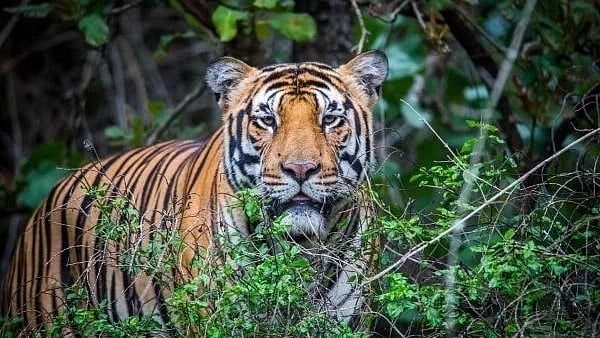
Representative image of a tiger.
Credit: DH Photo
A recent incident from Bandipur Tiger Reserve caught national attention: a middle-aged man narrowly escaped death while trying to take a selfie with a wild elephant on the highway. The video went viral, sparking heated debate on social media. Fortunately, the man survived without injuries. Otherwise, his family would have faced an unbearable tragedy. What’s worrying is that he wasn’t the only one that day — several others attempted the same reckless stunt.
Episodes like this are not rare, and they call for serious reflection. Without proper solutions, such incidents can end in tragedy for people and also create serious problems for wildlife. If you watch the video closely, the tusker can be seen pulling carrots from a truck. This tells us something crucial: the elephant already knew that vehicles often carry food and had grown accustomed to taking it.
This habit doesn’t develop overnight. For years, people driving through forests have been feeding animals — peafowl, bonnet macaques, langurs — with fruits, biscuits, puffed rice, and more. In recent years, this harmful practice has spread to deer, elephants, and even sloth bears in parts of North India. The intention may seem kind, but the consequences are dangerous, both for humans and for the animals themselves.
Take the case of the Dimbham Ghat in Tamil Nadu, where truck drivers once began feeding elephants with sugarcane and vegetables. The practice soon spread to the highway through BRT Tiger Reserve in Karnataka. Social media influencers romanticised it as “compassion” for wildlife, and many followed their example. It wasn’t long before Bandipur saw the same trend. What started as a seemingly kind gesture turned into a chain reaction of copycat behaviour.
Elephants are intelligent. Some began waiting by the roadside for handouts. Over time, tuskers even started blocking vehicles to snatch sugarcane or vegetables. This poses a very real danger: it is only a matter of time before someone loses their life. And when that happens, the blame will fall on the elephant. Pressure will mount to label it a “dangerous” animal, capture it, and send it to a camp. From there, its fate would likely be to perform tricks for tourists — saluting VIPs and accepting bananas from visitors — instead of roaming free in the wild where it belongs.
Some may argue that drivers and visitors engage in such behaviour out of ignorance. But we often overlook the signboards installed by the forest department clearly warning people not to feed wild animals. Even when we notice them, many choose to ignore the instructions — a troubling human trait. What’s worse, this harmful practice of feeding wildlife is sometimes justified even by environmentalists and animal lovers. Unfortunately, they fail to realise that such misplaced “compassion” can eventually become a noose around the very animal’s neck.
Sadly, misguided “compassion” doesn’t end there. In another incident inside Bandipur, a KSRTC bus driver honked loudly to chase away a pack of wild dogs (dholes) hunting a sambar deer near the highway. Disturbed by the noise, both predator and prey scattered. But the driver and a few others went further, shouting and even pelting a stone at the wild dogs to “save” the deer. Ironically, the wild dogs were only doing what nature intended them to do — hunt to survive.
Similarly, during summers, environmentalists and animal lovers often promote providing water artificially to wild animals. But if that is considered compassion, should we also extend the same to every tree, shrub, and herb in the forest? After all, plants provide food, shelter, and countless benefits to wildlife. Should we then install sprinklers or drip irrigation systems across entire forests to keep them green?
What we often overlook is that artificially providing resources to wild animals can unnaturally inflate their populations, even though their habitats are not being expanded. This is particularly true for species like elephants, which have no natural predators — apart from the rare instance of a calf being taken by a tiger. Natural challenges such as water or food scarcity during harsh summers or the long-distance movements elephants undertake result in some mortality, which is essential for maintaining population balance. Rather than interfering with these natural processes, our efforts should focus on securing habitats and protecting wildlife from threats such as poaching.
Wildlife conservation is already a complex challenge, and these misplaced acts of kindness make it even harder. Fuelled by WhatsApp forwards and social media “experts”, people often demand interventions that ignore ecological realities. For instance, when wild animals are injured naturally, there is pressure to treat them — forgetting that natural deaths are part of the ecosystem. Carcasses sustain vultures, hyenas, jackals, insects, and countless others. By interfering in every natural process, we risk destabilising entire food webs.
True compassion for wildlife does not lie in feeding them or “rescuing” them from natural events. It lies in respecting their autonomy and ensuring they have safe habitats to live in. Unlike our pet dogs or cats, wild animals are part of a larger ecological balance that humans cannot replicate.
Compassion towards animals is one of the noblest human traits. But when applied wrongly, it becomes a curse for wildlife. The best compassion we can offer elephants, wild dogs, and every other species is to protect their forests. That is not charity — it is our duty.
(The writer is an active conservationist and scientist)